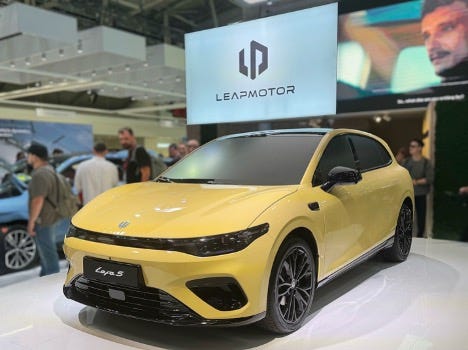China Marches Into Europe
Monster Speed and Scale
In the good old days, automakers chose speed or scale to separate themselves from the pack. General Motors and Volkswagen dominated the market with their size. Honda and Mazda beat you with agility. Never had the industry faced a competitor that was both George Foreman and Sugar Ray Leonard.
Never, that is, until now.
China brings both.
Standing in the giant halls of IAA Mobility 2025 in Munich last week, it hit me: this match may be over before it even begins.
Speed Meets Scale
A total of 14 Chinese automakers showed up in Munich — more than the number of European brands. Most of these names are unfamiliar in Europe: Leapmotor, Changan, Dongfeng. But don’t be fooled.
Chinese carmakers have already captured 10 percent of the market in both the UK and Spain. Across Europe, they now hold nearly 6 percent of the total market, and in EVs, their share approaches 10 percent.
And they are doing it not just with EVs, but also with plug-in hybrids and gasoline models.
What makes the Chinese advance so formidable is the combination of speed and scale.
Relentless Speed
Rapid development: Legacy automakers often take three to five years to develop a new model. Chinese brands can do it in as little as 18 months, using massive dedicated workforces, parallel development processes, and advanced software modeling.
Startup culture: They run more like Silicon Valley firms than traditional OEMs: lean, flat, and agile. Bureaucracy is stripped away. They hustle, improvise, and pivot quickly when markets shift.
Flexibility: When a model flops, it’s quickly trimmed or recalibrated. BYD entered Mexico with only EVs, then quickly shifted to a mix of EVs and PHEVs when the market signaled demand.
Direct access: Meetings can happen at a moment’s notice. I was able to sit down with a top executive at NIO on a Sunday — no assistants, no layers of handlers, no waiting weeks for a slot. That kind of responsiveness is unthinkable at a legacy OEM.
Massive scale
Chinese vehicle exports are flooding into Europe and over 100 other countries. In July alone, they hit 750,000 units — an annual run rate of nine million. That’s up from just one million in 2020.
Changan builds three million cars a year — more than Fiat, Renault, and Peugeot.
BYD has vaulted to global EV leadership and will begin producing the Surf in Hungary next quarter. The company runs its own shipping fleet of eight ocean-going vessels, capable of moving over 1 million vehicles annually.
CATL, the battery juggernaut, is planning factories in Spain, Hungary, and Germany by 2026.
And Chery is already producing EVs in Spain under the revived Ebro badge.
Monster Momentum
China’s rise is not just about exporting cars; it’s about building ecosystems. At the show, Chinese booths included not just automakers but also suppliers like CATL, Horizon Robotics, and Huawei, embedding themselves across the industrial chain.
China sent 116 exhibitors to Munich this year — the largest foreign presence by far. Even with tariffs in place, Chinese automakers doubled their share of the European market over the past year. BYD’s European boss Stella Li was clear: “We are in Europe to stay.”
RJ Scaringe, Rivian’s founder, cut through the noise:
“The part that everyone needs to take note of is that these are technically very advanced vehicles. With the exception of Tesla and Rivian, they are more advanced than most Western vehicle manufacturers.”
That’s the heart of the matter. The Chinese are not just fast and cheap. They are fast, cheap, and technologically sophisticated.
Mounting Pressures
European carmakers did not roll over. BMW, Mercedes, and Volkswagen came with fresh EVs boasting long ranges, fast charging, and digital cockpits. They are investing tens of billions to claw back lost ground.
But the battle looks uphill.
The Germans have shed 50,000 jobs in the past year.
Volkswagen’s CEO conceded U.S. tariffs are costing billions each year.
Even with European tariffs in place, Chinese models often remain cheaper while offering longer ranges, faster charging, and sophisticated software. Meanwhile, Chinese brands are opening R&D centers in Munich, building experience stores across Europe, and partnering with local players to look and feel European.
The Bottom Line
The Chinese march into Europe with monster speed and monster scale. They are George Foreman and Sugar Ray Leonard rolled into one.
Europe is fighting hard. But in Munich last week, the sense was unmistakable: Chinese automakers bring both the lightning right jab and the devastating left hook.




I have lived in China for over 15 years. Back then in foreign brands VW was king, it has been in China since 1978, but Audi was "the" luxury car. Chinese brands were like early Japanese cars. They were small. very light with manual tranny & small engines.
Then the change happened overnight, when China decided EV's were the future.
Thank you, a good read. The consistent way I hear folks underestimate the Chinese staggers me. “Be like water” as they say.